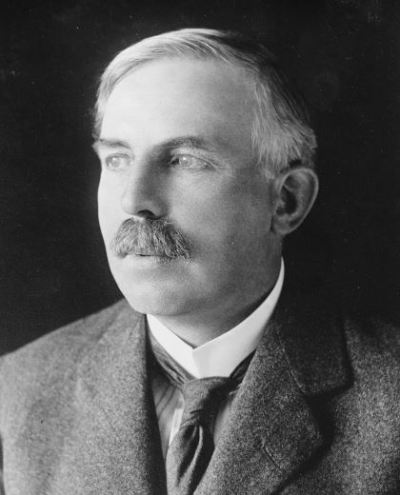The great physicist Ernest Rutherford famously said of science: “If it isn’t physics, it’s just stamp collecting.” I often think Iowa farmers must feel similarly about farming, i.e., “if you aren’t growing corn, it’s just gardening.”
If you’ve heard farmers talk about growing corn, you know it’s more than about making money. They love watching it grow and the grain pour into the combine’s hopper and then into the wagon or truck. It’s satisfying for the farmer to see the yield monitor hit 300 bushels per acre in a field’s sweet spot, and they love the uniform deep green beauty of waist-high corn blanketing the undulating hills reminiscent of Grant Wood’s art.
Indeed, corn is the Babe Ruth of crops, and Iowa is Yankee Stadium. The Iowa farmer is manager Casey Stengel, winning the pennant year after year after year. Our thick topsoils allow corn roots to penetrate five feet or more to get moisture when our usually-dependable rain gets sparse, and our average temperatures are in Goldilocks territory (just right) for this king of grasses.
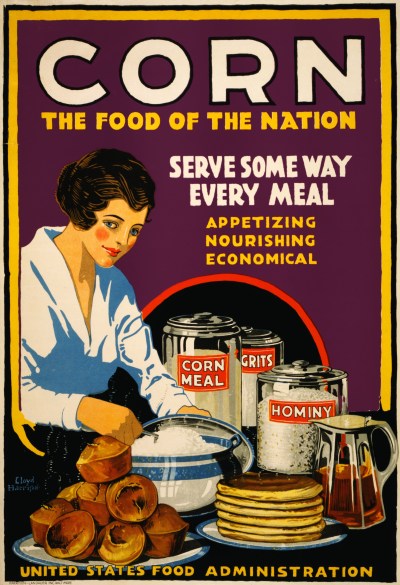
Since the day Europeans arrived in Iowa, our farmers have considered it their birthright to grow as much Zea mays L. as they wanted. The amount produced by Iowa farmers and their counterparts in other states has always been more than our country has needed.
Until about 1800, most corn was actually used for human nutrition. Even as recently as 1880, corn flour provided 650 (!) calories per day for the average American (It’s less than 20 now). Ever since then, however, we have been trying to figure out ways to use the surplus that we could not eat ourselves. By 1910, American farmers were already producing 1500 pounds of corn grain per year for every person in the U.S., and that number now stands at more than 2200 pounds per person. Our government has been helping farmers figure out what to do with it all since the 1930s.
After 1910 and until recently, the vast majority of corn we didn’t eat was fed to livestock, and especially cattle. From 1929 to 1975, our per capita appetite for beef increased from 50 to 120 pounds and poultry consumption increased from 14 to 40 pounds. Our total consumption of animal products (meat, eggs and dairy) now totals a little more than 610 pounds per person per year. Since it takes about nine units of vegetable protein to create one unit of animal protein on average, a lot of corn (and soybeans) is needed to satisfy our meat cravings. Export markets also absorbed a lot of our excess corn prior to 1980.
In recent decades the amount of corn needed for animal feed has flattened out, not having changed much since 1980. At the same time, corn exports have also been relatively stable (although increasing a little the last 2-3 years). Corn yields, however, keep going up and up and up and have increased from about 100 bushels per acre in 1980 to about 175 today.
An Iowan reading this likely knows that the fate of these extra corn calories has been fuel ethanol. About 40% of our corn and 14% of our land area is now committed to ethanol production.
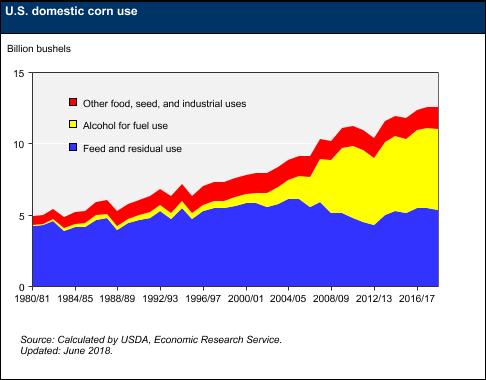
I can recall filling my first car, a 1969 Dodge Dart, with a gasoline/ethanol blend in the late ‘70s. However, use of corn for fuel did not take off until about 15 years ago, when the Energy Policy Act of 2005 expanded the amount of biofuel (usually ethanol) required to be mixed with gasoline. Currently EPA is requiring that liquid fuels sold in the U.S. contain in total at least 19.9 billion gallons of renewable fuel, and this amount is slated to increase further. Soybeans are also made into renewable fuel (biodiesel, biomass-derived oil or blends of diesel fuel and biomass oils) and EPA will require 2.43 billion gallons of that stock to be used in 2020.
In order to accommodate biofuels, vehicle manufacturers have modified engines on some models so they can operate on blends that contain more than the traditional 10% (by volume) of ethanol. In 2011 EPA approved sales of 15% blends and now some engines can operate on blends that are as much as 85% ethanol (E-85). Almost all car owners in the U.S. now routinely fill their tanks with ethanol blends.
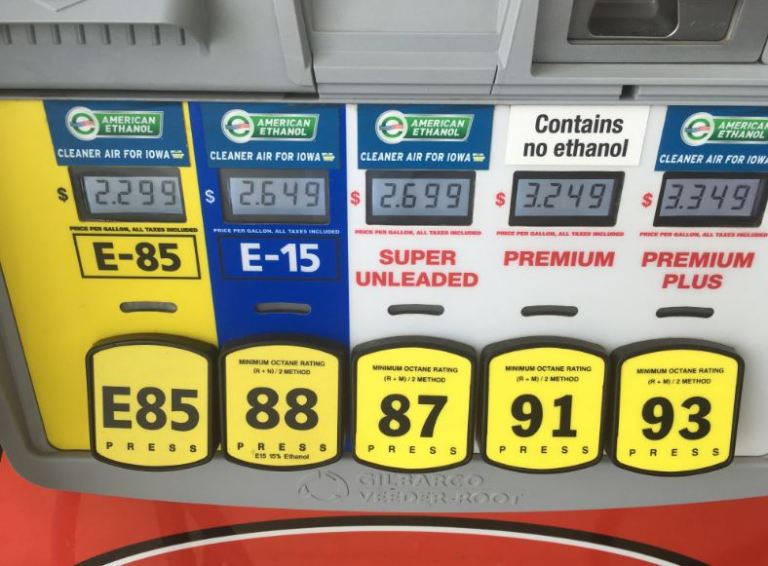
The lower price of these mixtures helps make up for the lower gas mileage that most cars get when fueled by them. This is largely because an ethanol molecule only has two carbon atoms while the hydrocarbons of gasoline contain between 4 and 12. A gallon of E10 contains 96.7% of the energy of pure gasoline, meaning a car that could be expected to get 30 miles per gallon will get 29 with E10. This is one reason why new cars seldom get the predicted mileage shown on the show room sticker, which is based on pure gasoline.
Using the pump prices shown in figure 3, it would cost $0.093 per mile on E10 ($2.699/gal) and $0.108 per mile on pure gas ($3.249/gallon), so E10 makes economic sense for the driver. If the consumer wants pure gas, he/she must buy premium at 91 octane at this station, about 5% more expensive than the normal 87 octane that had been sold at most stations until recently. Cost per mile using that fuel would be $0.102, still higher than E10.
E85 is not really a bargain; although it can vary, fuel efficiency with it is usually about 25% less than pure gasoline. That means it costs $0.102 per mile in the example car of above.
Strictly from a thermodynamic standpoint, biodiesel makes more sense as a fuel than does corn ethanol blends, as fuel economy can actually be better than regular diesel. Biodiesel also costs more than regular diesel. Biodiesel fuels have not caught on the way ethanol-blended gasoline has. The reasons for this are complex and likely related to storage, performance, and policy. Even Iowa farmers are loathe to use their own soy biodiesel, with only 8% of on-farm diesel sourced back to renewables.
There’s been a virtual mountain of peer-reviewed literature on the environmental pros and cons of crop-derived fuels. I analyzed at a lot of data on this topic several years ago in a previous job and I’m not at liberty to discuss the details of that, but I will say that I am convinced biofuel use modestly reduces greenhouse gas emissions. Whether the environmental tradeoffs linked to land use and water quality are worth it and how they compare to fossil fuel extraction—that is a policy decision, but I think it is pretty clear that is not what is driving policy.
Rather, policy is being driven by farm state zeal to continue doing what is done best: produce corn. It’s our birthright, and unlike just about any other industry, we feel like we ought to be able to do as much of that as we want to and it’s up to the rest of the world to figure out what to do with it. I’m not saying there hasn’t been an upside to this for Iowa; clearly there has been. But it also has led us into the hubristic “feed the world” rhetoric and some other mendacious half-truths to justify our near-nonexistence of public land and degraded water quality. And the truth is, a lot of other countries are getting pretty good at growing King Corn (Fig. 4).
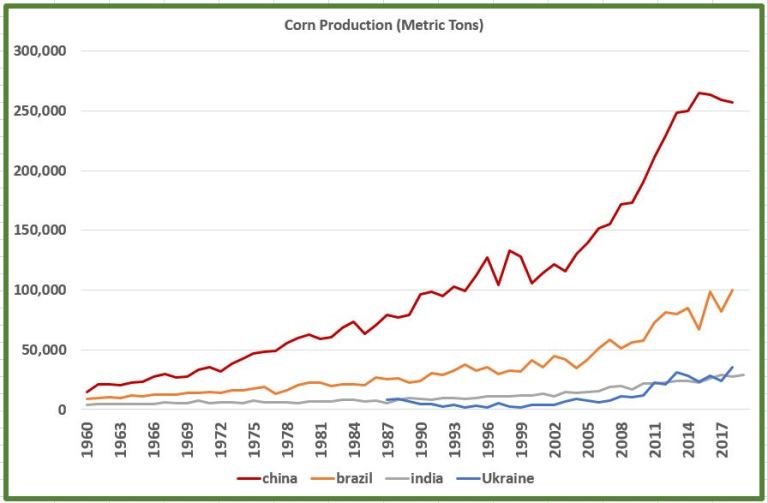
I think it is undeniable that biofuels and especially corn ethanol have provided the country with energy benefits. But the need for liquid fuel may not always accommodate our piles of corn. While supplies of metals such as cobalt, copper, and nickel needed for batteries may be limiting, electric vehicles appear to be the future of a ground transportation. Electric cars already make up nearly 2% of the vehicles in Europe and year-to-year growth is nearly 67% there. At that rate, it will not take long for them to outnumber hybrids. And as more governments around the world try to work for a carbon-neutral future, the demand for liquid fuels appears poised to decline. It will be interesting to see how Iowa and other cornbelt states respond to this and other energy trends.

